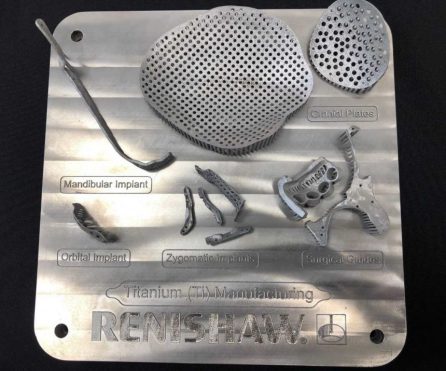When I say that I work in robotics, automation, and artificial intelligence (RAAI), the first things most people think of are humanoid robots (think Star Wars), AI (think Alexa), or self-driving cars (think Tesla). But the spectrum of RAAI transcends the obvious. ROBO Global index member Renishaw, the oldest and perhaps boldest player in the world of 3D printing, is just one example. Established in 1973, the company is transforming the application of additive manufacturing—more commonly called 3D Printing—in healthcare, precision measurement, and more. The only UK business that designs and makes industrial machines that ‘print' parts from metal powder, Renishaw supplies products and services used in applications as diverse as jet engine and wind turbine manufacturing, dentistry, and brain surgery.
Last week, I was among the fortunate few who were invited to an inside look at the company’s latest innovations. During the all-day session at Renishaw’s headquarters and Innovation Centre in Gloucestershire, UK, I was tremendously impressed by the company’s leadership and culture, by their research processes, and by their products. I walked away feeling a lot like a kid in a robotics candy store.
Renishaw has been a member of ROBO Global Index since the index’s inception in 2013, and the company continues to demonstrate the three primary selection criteria for inclusion in the index: technology leadership, market leadership, and a focus on long-term growth. It’s no surprise they’ve remained so keenly focused on these objectives. Renishaw has relied heavily on the strength of its R&D approach to maintain its leadership position for nearly 50 years. Last week, that R&D focus was evident at every turn. Here are my five key takeaways from the day:
1: Research drives everything they do.
At Renishaw, the term ‘additive manufacturing’ is preferred to the more common ‘3D printing’ for good reason. While many 3D printing firms focus on simply building out existing designs using the efficiency of 3D printing processes, Renishaw focuses on design first, rethinking and reanalyzing every component to fully optimize the opportunity of 3D printing. This approach is helping them deliver some of the lightest, strongest, most innovative products available on the market today.
2: Their products are nothing short of mind blowing.
I was particularly impressed by demonstrations of perfectly precise dental implants, and by pieces of the human skull that are used in traumatic brain surgery. While many of the company’s product developments are shrouded in secrecy due to client NDAs, as an America’s Cup fan, I was thrilled to see up-close one of the complex hydraulic components designed for one of the boats. Far from a mere reconstruction of a traditional part, the team at Renishaw designed a unique component to meet a specialized requirement. The deliverable is a game changer that could never have been imagined without 3D printing.
3: Their passion is palpable.
From senior management to the younger engineers and computer scientists who were presenting products they had designed themselves, it was clear that the entire team is thrilled to be doing what they are doing, where they are doing it. And due to the company’s highly positive reputation among computer science and engineering graduates, job seekers are queuing up at the doors in hopes of working at this dream company! Clearly, Renishaw has what it takes to hire and keep good talent.
4: Their strong leadership team has successfully transitioned to the next generation.
Founder Sir David McMurtry transitioned from CEO to deputy chairman this past February, handing over the CEO position to William Lee, a company insider who joined Renishaw in 1996 in new product research. Lee subsequently headed up the laser and calibration product lines and the machine tool product line before being appointed to the board as group sales and marketing director in 2016. With a degree in physics from Oxford University and an MBA from Bath University, plus more than two decades at the company, Lee seems to be an ideal choice to lead the company forward.
5: Their global presence points to continued revenue growth.
The company currently has more than 70 offices in 35 countries, and more than 4,700 employees worldwide. Around 50% are employed within the UK, where the company carries out the majority of its R&D and manufacturing, and 50% are employed at their six regional service centres that enable them to provide low-volume prototypes and demonstrate their innovation and excellence to clients and prospects worldwide. Asia is just one of many areas where sales are booming.
At ROBO Global, we estimate that additive manufacturing is a $6B market today, with potential to rise to over $50B in the next five to ten years as the technology expands from prototyping to production of consumer and professional end-use parts. The combination of additive manufacturing and AI looks particularly promising, enabling not only shorter design-to-production cycles, but also entirely new architectures and designs for a wide variety of common parts. In 2016, General Electric spent more than $1B to acquire 3D printing companies, including ROBO Global index member Arcam EBM. GE expects its additive manufacturing initiatives to save more than $3B in manufacturing costs by 2020. GE and Renishaw are just two examples of innovators who are applying additive manufacturing to transform the manufacturing industry as we know it.
Perhaps one of the most compelling differentiators Renishaw holds today is that its products are not confined to 3D printing alone. While their additive manufacturing processes certainly place them in a leadership position in that space, Renishaw’s capabilities reach far beyond basic scan-and-print prototyping. Building on the company’s long history of metrology excellence, they have incorporated these capabilities into their machines to support extensive software/CAD design capabilities. The result: in 2018, Renishaw is fundamentally rethinking and redesigning the future by optimizing the potential of additive manufacturing. I, for one, absolutely cannot wait to see what Renishaw’s future holds—in 3D printing and beyond.
By Richard Lightbound, CEO, EMEA, ROBO Global





